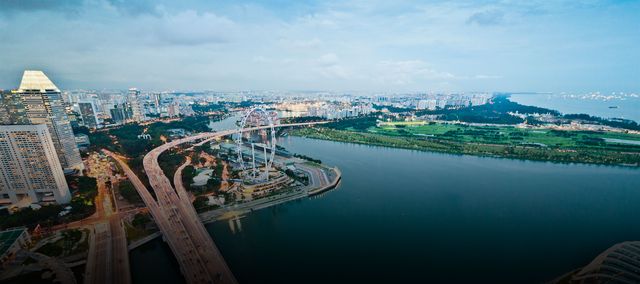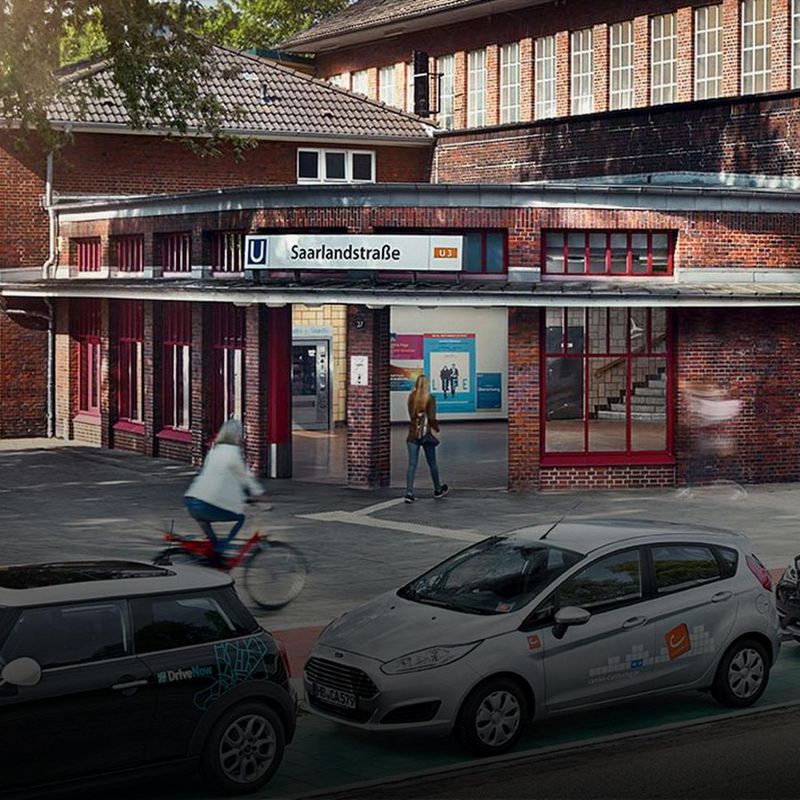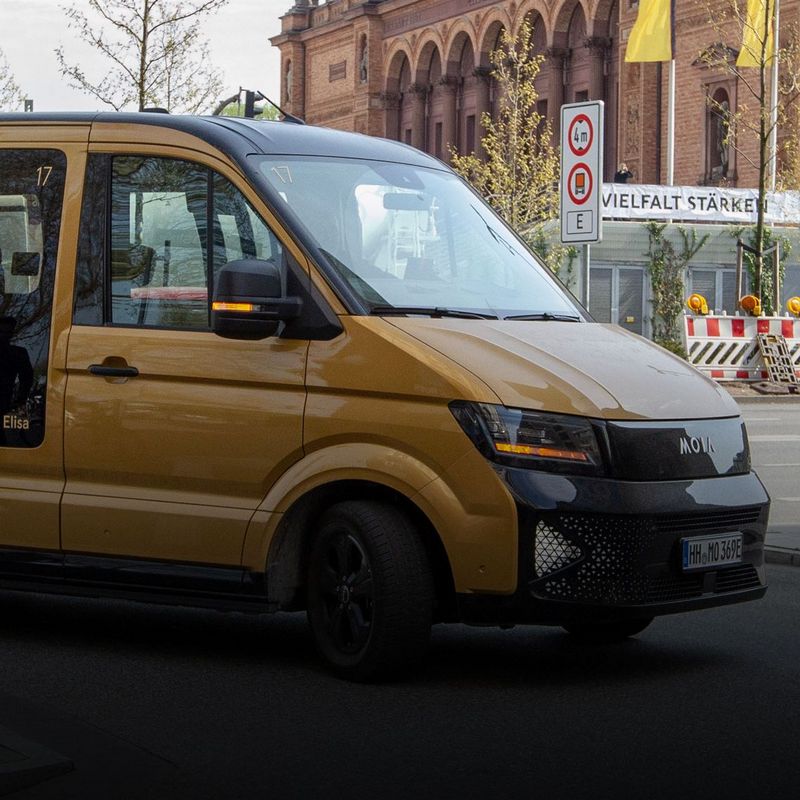20 February 2020
Hearing the words Smart City might conjure up images of tablets on every lamppost and all manner of fabulous future visions. And yet, a lot of cities around the world are already trying to use technology to become more efficient, greener and nicer to live in. We looked at three cities which have made a particular name for themselves in this area.
Over half of humanity now lives in urban centres - by 2050 the proportion will be almost three-quarters. And the greater the number of people streaming into the cities, the more daunting the challenges to be overcome by the municipalities. Ever larger numbers of local authorities are looking to Smart City concepts for answers to the issues of clogged roads, air pollution, wasted energy, scarce resources and demographic change. Cities are aspiring to become more efficient, more sustainable and cleaner and to offer their citizens a better quality of life by using modern technologies in the energy sector, mobility, urban planning and administration, alongside comprehensive connectivity. But it takes more than just the odd innovative project or initiative to make a city smart; this, at least, is the assessment of consultants from Roland Berger in their Smart City Index 2019. If they are to be fully effective and actually make a city smarter, different measures should employ a holistic concept to ensure that they dovetail and are connected with one another. This year’s winner in this respect, according to the analysts, is Vienna. And it’s in the Austrian capital that our smart journey begins - with further stops in Singapore and Hamburg.
Vienna
For the second time in a row, according to the Smart City Index 2019, Vienna can boast of its credentials as the world’s smartest city. At first glance, this venerable city on the Danube does not come across as the kind of high-tech metropolis that most people would imagine a Smart City to be. And yet, behind the historic facades and on the streets of the erstwhile capital of the Austro-Hungarian empire, the city has more than its fair share of innovative projects. Vienna was the first city in the German-speaking world to make its administrative data available to all; it also offers public Wi-Fi at over 400 locations. What’s more, residents can now manage various bureaucratic official matters, including registration for nursery places, online or talk to chatbots on their smartphones to find answers to all sorts of questions about the city and its public services.
The WAALTeR pilot project is investigating whether telemedicine, fall sensors and other digital aids can help senior citizens lead independent lives in their own four walls. In the first street in Vienna to have been adapted to climate change, newly planted trees, shady benches and arches that spray water offer a welcome refuge from the summer heat - meaning that children, senior citizens and sick people in particular suffer less from the extreme heat that is increasingly likely to become the norm as global warming takes hold. The idea is for “cool miles” to follow in other districts too.
© ZOOM.ATModel picture of the cool mile in Vienna.
Vienna is also setting a range of trends when it comes to mobility and energy. Alongside a public transport system which is widely considered to be a global benchmark and is used by nearly 40 percent of all the city’s inhabitants, pedestrians will soon be recognised by 200 traffic lights when they line up to cross the road. Austria’s first fully electric bin lorry has been quietly collecting the city’s waste without a single carbon emission since May 2019. The Samaritans are now using electric cargo bikes to deliver their Meals on Wheels. Excess power from wind or solar is converted into heat in a power-to-heat installation. As part of the EU-funded project “Smarter Together”, blocks of flats in the Simmering district have been overhauled to make them more energy-efficient, and a school has been equipped with zero-energy sports halls. With solar panels, solar thermal generation and heat pumps, the underground sports halls generate as least as much energy as they consume.
Many of these smart initiatives and projects are centred on the “Seestadt Aspern” a new Viennese city project based around an artificial lake. On the site of a former airfield, a climate-friendly district is being built with short connecting roads, lots of space, greenery, resident participation and as few cars as possible. The idea is for 20,000 people to be living here and the same number again to be working here by 2030. Today, this flagship urban planning project has 7,500 inhabitants, some of whom live in smart buildings. These real-life laboratories for energy provision are leading research into how intelligent control and networking can optimise energy generation, storage and consumption to relieve strains on both the environment and the finances of the residents. The key finding from the first project phase is this: compared to a conventional heating system, smart house building can save over 70 percent or just under 240 tonnes of CO2 emissions per annum.
Singapore
Singapore takes fourth place in the Roland Berger Smart City Index 2019; in the parallel McKinsey ranking in 2018, the city-state topped the list. Singapore has ambitions beyond merely being the world’s first botanical capital city. Since 2014, this tropical city-state has been using a comprehensive development plan to catapult it up the ranks to become the world’s first Smart Nation - and this for very specific reasons. As an island state of about half the size of Hamburg, Singapore doesn’t have the option to grow outwards. But vertical growth is increasing the density of both living space and traffic.
© Getty ImagesSingapore is always at the forefront in various smart city rankings.
It’s for this reason that the immense flow of people and vehicles is now going to be regulated using digitally optimised traffic flow management. The “Intelligent Transport System” uses cameras and sensors to map traffic volume in the city in real time. This enables the city’s planners to identify bottlenecks in the road grid and to try to relieve the situation by adapting traffic light phasing. A well-developed public transport network, a system of certification for new registrations and a toll system with prices which vary from one route and time of day to another are moreover intended to relieve traffic congestion and limit the number of cars. The government has set its sights on self-driving vehicles to encourage ever larger numbers of people to leave their cars at home. The NuTonomy start-up began tests of its robotaxis in 2016 - albeit with a safety driver still on board. By no later than 2022, driverless buses should be ferrying the residents from the city’s suburbs to its traffic nodes. Generally speaking, the people of Singapore are very open to new forms of mobility: It was here, in October 2019, that the first electric flying taxi, Volocopter, embarked on its maiden manned flight over a major city.
The city-state is also setting new benchmark standards with its digital infrastructure. For instance, Singapore was the first metropolis to offer city-wide free Wi-Fi. Its broadband network is considered one of the best in the world. In the course of its “smart” national health initiative, Singapore has largely digitalised its health communication, as well as introducing telemedicine services, and is testing the deployment of robots and AI in a hospital. In the form of the SingPass, the city has introduced a digital ID system: Citizens can use the associated app to access administrative services - and will in future be able to order birth certificates, wedding appointments or evidence of pension entitlement at the touch of a button.
Hamburg
In 2019, the Bitkom industrial association drew up its first ever Smart City ranking for German cities. All the country’s 81 cities with populations of 100,000 or greater were analysed and evaluated. First place was awarded to Hamburg - followed at some distance by Karlsruhe, Stuttgart, Berlin and Munich. The Hanseatic city scored particularly highly in the areas of society, energy and the environment. For instance, Hamburg has relied on Open Data since 2013 and plans to use suitable online services to make ever larger numbers of official procedures redundant, including applications for child benefit. No other German society currently boasts as many public charging stations for electric vehicles. The HVV and Hochbahn transport companies are already using, among other vehicles, some 50 electric buses to ferry their passengers from A to B; as of 2020 they will be buying only electric or fuel-cell-operated buses. 16,000 households in the eastern part of the port city are being heated by waste heat from a local copper plant - saving some 20,000 tonnes of CO2 per annum. Heat pumps and ice storage tanks are being used to supply residential buildings, the Elbcampus and a food laboratory with heat in the winter and cooling air in the summer. Some 70 percent of emissions are thereby being avoided.
© alamyNew mobility solutions make Hamburg smart.
In respect of mobility, residents and visitors to the Hanseatic city can make use of a wide range of sharing services from various providers, including the digital shared taxis offered by Moia or Deutsche Bahn subsidiary ioki. As the host of the global ITS congress for intelligent traffic systems in October 2021, Hamburg is currently pursuing some 60 mobility projects: parking spaces equipped with sensors which tell users when they are free, and automatic traffic counts using 2,000 thermal imaging cameras at 420 crossroads which are designed to recognise cars, cycles and pedestrians anonymously in real time. The aim is to control the traffic more effectively in acute cases and improve long-term planning. Hamburg is also planning to make available the data from the city’s traffic lights to help ease congestion. Carmakers, start-ups and app developers would then be able to use the data to provide both drivers and cyclists with forecasts of the speed they will need to move at to catch the next green light or how long the lights ahead of them are going to stay red. The city successfully tested one such traffic light assistant in collaboration with Audi in 2018. Users of public transport should also benefit from the new digital possibilities: using an automated ticketing system which will make using buses and trains as convenient and low-cost as possible. They are also set to benefit from smart lockers in urban and regional stations to which commuters or travellers will be able to have parcels delivered.
Self-driving buses are being tested in the nearby town of Lauenburg and in the Hafencity district. The aim is for the HEAT bus to be moving around freely in real traffic situations, even without a safety driver, by the time the ITS world congress kicks off in October 2021. The robot bus is currently being trialled on part of the test route for autonomous and networked driving, known by its German acronym of TAVF, on which Volkswagen tested five self-driving e-Golfs in 2019.
Depending on their equipment, the smart lamps will also provide Wi-Fi to the residents, measure pollution levels or serve as charging stations for electric vehicles.
In the district of Bergedorf, some buildings are undergoing an energy-saving makeover and new more environmentally sound blocks of flats being built in the context of the EU-funded “mySMARTLife” project. Smart electricity meters and control technologies monitor, control and improve energy consumption. Heat pumps and ice storage tanks are being linked together to create a district heating network to supply the district with sustainable heat. In one residential district, tests are underway to determine to which extent conventional natural gas can be replaced by hydrogen produced using green electricity.
As in Vienna, elderly people in Bergedorf should be able to live independently at home for longer thanks to smart home control systems. The system, which is set to be installed in the first few households in early 2020, will warn senior citizens if a window is left open or the oven is still on, as well as offering automatic energy-saving support. Users will also be able to contact or book in local household assistants via a tablet. The aim is for everyone in Bergedorf to benefit from smart streetlamps. These lamps will glow more brightly when a pedestrian or a cyclist approaches. Depending on their equipment, the smart lamps will also provide Wi-Fi to the residents, measure pollution levels or serve as charging stations for electric vehicles. “mySMARTLife” is just limited to Hamburg: The project is being jointly run by the Hanseatic city, Helsinki in Finland and the French city of Nantes. The concepts being developed and trialled here are also intended to be blueprints for other cities.





